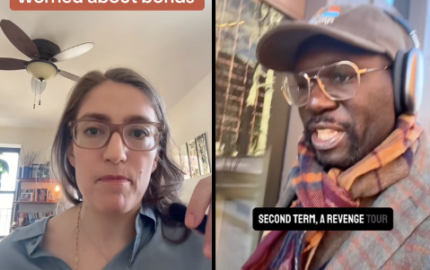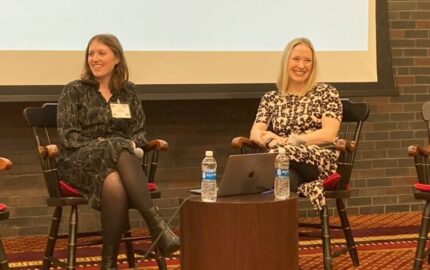
Whether they use full-on storytelling or just crib a few literary devices, interviews have their own narrative arcs and angles. From political drama (think the Frost-Nixon standoff or “The Fog of War”) to Studs Terkel’s cultural layering,interviews create a kind of permanent present-tense experience for viewers.
Two recent magazine interviews underline the narrative potential of the form. The first, “Insane Clown Posse: And God created controversy,” runs through a dizzying talk with the rap duo on The Guardian’s website.
The conversation jumps off with the acknowledgement that despite their ultra-violent lyrics, the pair are evangelical Christians. Reporter Jon Ronson moves on to reveal that the performers suffer from depression. As the story unfolds, even those who contest the importance of hate-spewing clowns may find the interview compelling, funny and disturbing, and perhaps not in predictable ways. Here’s an excerpt of Ronson’s dialogue:
Violent J shakes his head sorrowfully. “Who looks at the stars at night and says, ‘Oh, those are gaseous forms of plutonium’?” he says. “No! You look at the stars and you think, ‘Those are beautiful.’ ”
Suddenly he glances at me. The woman in the video is bespectacled and nerdy. I am bespectacled and nerdy. Might I have a similar motive?
“I don't know how magnets work,” I say, to put him at his ease.
“Nobody does, man!” he replies, relieved. “Magnetic force, man. What else is similar to that on this Earth? Nothing! Magnetic force is fascinating to us. It’s right there, in your f**king face. You can feel them pulling. You can’t see it. You can’t smell it. You can’t touch it. But there’s a f**king force there. That’s cool!”
Shaggy says the idea for the lyrics came when one of the ICP road crew brought some magnets into the recording studio one day and they spent ages playing with them in wonderment.
“Gravity’s cool,” Violent J says, “but not as cool as magnets.”
The struggle between interviewer John H. Richardson and actor Christian Bale in Esquire’s December issue is more convoluted. As Richardson attempts to build a narrative that illuminates Bale as a person, the temperamental actor throws up roadblocks, refuses to participate, and ends with an insult to his interviewer’s efforts to reveal anything at all about him.
The narrative builds and destroys itself, eventually piling up a kind of story:
BALE: Why are you questioning those things?
ESQUIRE: Just curious.
BALE: Why are you putting all that muddle in your brain that’s not needed to be there?
ESQUIRE: I guess you just look at the choices people make and wonder, What’s up with that?
BALE: But why are you worrying so much about everybody else? Let’s start looking at you for a minute, all right?
A standoff ensues not unlike the scene in Antonioni’s The Passenger when Jack Nicholson is interviewing a witch doctor who clearly thinks he’s an obnoxious idiot. “Your questions are much more revealing about yourself than my answers will be about me,” the witch doctor says, turning the camera around so it’s pointing at Nicholson. Major existential moment as Nicholson stares into the abyss between sign and signifier. But we have seen this movie, and it does not turn out well — the spell must be reversed.
BALE: It should just happen. It should just happen. If something’s true and sincere, it happens regardless of marketing. The more I talk about it, the more I’m telling people how they should react. And that is an asshole.
ESQUIRE: Not to argue, but that's not really true.
BALE: Are you calling me a liar? Am I lying?
ESQUIRE: Sometimes the ground needs to be prepared. And you’ve laid down these onerous rules on me — all I can do is a Q&A.
Actually, these are forbidden words that you are reading right now. Bale is in the habit of requesting that his media interviews be printed in a Q&A format. He also prefers to conduct them at the same five-star luxury hotel in Los Angeles, and makes it known that he dislikes personal questions.
Both these interviews end up far afield from straight transcription. The interviewer's after-the-fact insertion of connective tissue between segments of the Q-and-A shape the story arc and set the tone.
Very long long-form
“Diary of a Very Bad Year: Confessions of a Hedge Fund Manager” a book-length series of interviews, falls into an even longer-form category. Keith Gessen, editor of the political and cultural journal n+1, conducted a series of interviews in which a financial player chronicled the economic collapse and its aftermath.
In a phone conversation last month, Gessen described how in small and large ways, events in “Diary” began to take a narrative turn – not just in chronicling the meltdown but in the hedge fund manager’s outlook and life. Asked to what degree he imagined the book as narrative during the interview process, Gessen said,
I was very much thinking of it in terms of Studs Terkel, and there’s another book that I read some yearsago, an updating of Studs Terkel called “Gig.” That book is amazing. These people have these crazy jobs, and as they talk about them, details of their lives emerge.
With “Diary of a Very Bad Year,” initially, I just wanted to find out what was going on with the financial crisis. I knew I didn’t know what was going on, and I had this sort of acquaintance who I thought could explain it. After I did the first interview and transcribed it, I was surprised. It had a lot of information. He had a very charming way of explaining the financial system. Some very talented financial people need to be able to tell stories about what they’re doing – that’s just part of him being good at his job. He was so good at explaining it that you could see how he thought, his mind at work. I thought that was exciting.
At first, I just thought we’d put the interviews in the magazine. Halfway though, he became very frustrated with his job. At the end, he quit. I didn’t know for sure where we were going initially, but when he decided to quit, we had a whole narrative arc.
Contrasting doing long-form interviews with the kind narrative features he's written for the New Yorker, Gessen noted the different goals of the interviewer:
I’ve done a fair amount of traditional journalism where you’re interviewing people. There’s a very specific way in which quotes are used in a New Yorker article. They're partly there to be informative; they're partly used to reveal the character of the person who’s being informative.
When you do those interviews, you’re looking for a particular thing, a particular moment, from that person. You more or less know what you want from your subject. And I wouldn’t say it’s manipulation – that’s too strong a word – but because the frame that you’re putting on the story has so much weight, your subjects become characters in the story and have particular roles to play in it. When you’re doing those interviews, you're waiting for them to say a particular thing, as if they were fictional characters who were uncooperative.
With the hedge fund interviews, I wasn’t waiting for anything. I was waiting for him to be interesting. I wasn’t waiting very long. In a way, it was more pressure doing those interviews, because I wasn’t going to be able to write around him. So he had to be the one who was interesting.
Gessen was pleased enough with the hedge fund interviews that he searched out people from other fields, only to find not everyone was as engaging when it came to talking about work. But with the right interviewee, "to hear a live and intelligent and very particular human voice," Gessen said, "that’s very exciting to a reader and very immediately accessible – as accessible as anything."
Radio Q-and-A's
Though they have a long tradition in print, interviews own a sizable share of other media, as well, and many of them are narrative. Lisa Mullins, chief anchor and senior producer for Public Radio International’s “The World,” makes it a goal to frame real-time narratives as she interviews subjects. Talking by phone last week, she outlined her approach:
When I’m preparing an interview, I want a beginning, a middle and an end. It may not stay that way when I actually execute the interview, but it always helps to have an arc to the story and have some kind of a narrative. Sometimes that narrative centers on a subject – meaning the issue that we’re talking about – or sometimes the narrative unfolds from the person’s own thoughts and history. It can go either way, but I like to have a start and a finish and then a takeaway – something that the audience will come away with at the end.
I honestly don’t believe that we always need a neat and poignant ending. We need some kind of end thatdoesn’t sound random. It has to be something that makes the interview whole, that gives it a sense of direction and gives listeners a sense they’ve taken a mini journey someplace, even if they haven’t gone anywhere, even if it’s just a Q-and-A on the telephone.
Mullins doesn't employ storytelling out of a sense of duty to tradition. Her motives, she admits, may be a little more selfish:
One of the reasons I really cherish the practice of interviewing as narrative is, frankly, ego. A lot of what we do is to convince people that they will be interested, entertained and edified by whatever we’re presenting. But it’s not a given. I don’t take that interest for granted.
So my goal is to give them what I know is going to attract any listener: a really interesting story, especially around an issue they didn’t know they could be interested in. By working with this rubric of storytelling and narrative, no matter what you’re doing, you’re going to get a much better interview for yourself, you’re going to have a more cooperative interviewee, and you’re going to get the listener paying attention. It’s not like they’re being spoon-fed; they’re just being informed and entertained in the most natural way of all, and that’s through storytelling.
Mullins also emphasized the real-time role of the interviewer and the importance of discipline when a Q-and-A is going to be the final product – not to block spontaneous surprises from emerging, but to string a narrative thread that the audience can clutch, giving listeners "a place to touch down." Interviewers have a narrative role to play, even when they're not the ones telling the stories.
[For more on interviews as stories, read Lisa Mullins' tips for doing narrative interviews.]


